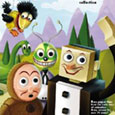Mushi Productions/Tezuka Productions (1962-1988), Kino (July 28, 2009), 1 disc, 151 mins plus supplements, various aspect ratios, Dolby Digital 2.0, Not Rated, Retail: $29.95
Storyboard:
The “god of manga” escapes from the tedium of assembly line television production to produce a series of sophisticated experimental animated shorts.
The Sweatbox Review:
When Tezuka Osamu died in 1989, he left an amazing legacy of work in the fields of comic strips and animation. Whether or not one sees him as a genius, one must admit the man was prolific. His works in the Japanese manga (comic book) field were so widely enjoyed that he became known as the “god of manga.” He went on to form Mushi Productions to produce animated versions of his popular Tetsuan Atom (known in the English speaking world as Astro Boy) and Jungle Emperor (Kimba) manga, to great international success. Unfortunately, the animation studio made a few missteps later on, which led to its financial ruin. It declared bankruptcy in 1973, three years after Tezuka had stepped down in 1970 and founded a new company, Tezuka Productions.
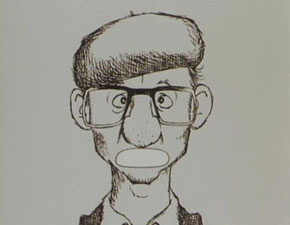
While with each company, Tezuka produced a number of smaller, less commercial works. He was more of a creator than a businessman, and yearned to create art more than commerce. This DVD follows his career within each of his studios, as he thrived to surpass the purely commercial work in order to push the boundaries of the medium. The results are often striking, as he employed a variety of styles to tell his stories. Very little of what appears on this DVD will remind anyone visually of Astro Boy. Instead, these are mature works by an accomplished artist, exploring new ways to promote his personal messages, which often carry themes of anti-war or of being in harmony with the world. In that sense, the works are in familiar territory, as fans of his manga and TV shows will know well the extent of his passions, summarized by his oft-quoted “Love everything that is life!”
Most of the shorts here are purely pantomime; only five have any dialog. This was likely both an artistic choice as well as a financial one. Aside from not needing to record dialog, it made the marketing and showing of these films overseas all the easier. It is important to note that the screen captures do not do the films justice, since almost every one utilizes more than one style; but to properly show that off, this review would have been mostly pictures!
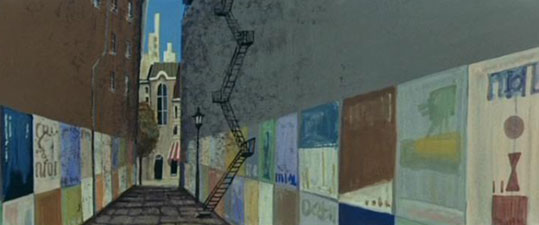
Tales Of The Street Corner (1962, 36:04) – The disc opens with the oldest and longest piece. Shot in a 2.35:1 ratio, this featurette examines life at a typical street corner in a typical town. At first, it reminded me of Will Eisner’s graphic novels, where he offered remembrances of his past, always set in his old neighborhood. For several minutes, we are led to believe that the film is simply about a girl who has lost her teddy bear, a group of mice, a moth, a lamp post, a tree, and some posters being displayed on a nearby wall. As the film continues, it is still their story; but their world changes as a military regime, represented by posters of a general, removes the influence of the arts in favor of war. The results are naturally devastating, and yet there are images of hope that show the power of both nature and the human spirit. The later work Legend Of The Forest gets lots of recognition as a mini-masterpiece, but Tales Of The Street Corner is at least as impressive. The use of imagery and metaphor to tell the story is masterful, and it did wonders to stimulate discussion with my little girl. She couldn’t understand a lot of it, and yet she found it utterly compelling. That says something.
Male (1962, 3:09) – This sad, disturbing short gives voice to a feline couple living beneath a man’s bed. While the male cat tries to speak man-to-man to the human male, the tragic difference between mankind and animals becomes brutally apparent. While most of these shorts can be enjoyed by children, this one is for more mature audiences.

Memory (1964, 5:40) – The nature of memory is explored, verbally and visually. Aside from many clever comments, an observation is given regarding what memory others may have of humankind in the future.
Mermaid (1964, 8:17) – A man imagines meeting a mermaid, but the state allows no such flights of fancy. Sequences in this film initially reminded me of Kubrick’s A Clockwork Orange, until I remembered that his film would not be out yet for a few years after this cartoon was created.
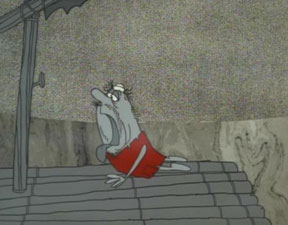
The Drop (1965, 4:18) – A shipwrecked man, floating on a raft in the ocean, desperately tries to acquire a single drop of fresh water . This is the most purely funny short on the disc, and with an ironic ending to boot. It’s also the least political.
Pictures At An Exhibition (1966, 32:56) – This series of vignettes, based on paintings in a gallery, is a bit hit-or-miss in terms of entertainment, but there are a few good scenes in there. I especially liked the tale of the bug looking for sustenance among an artificial garden.
The Genesis (1968, 4:02) – See what happens when God creates woman first and then man. I’m not sure what Tezuka was really trying to say, but I enjoyed watching it.

Jumping (1984, 6:22) – What begins as an interesting conceit, with the camera being the vantage point of someone jumping higher and higher through a city and across the ocean, becomes another anti-war film. More than that, though, there is a commentary on how man’s rapidly escalating technology outpaces our evolving moral sensibilities.
Broken Down Film (1985, 5:42) – This one begins as a cute riff on old-style cartoons, with the appearance of an old black and white cowboy animation. Similar to some of Tex Avery’s MGM cartoons, games are played with the nature of film itself. While still wholly original, this short is one of the most approachable for general audiences.
Push (1987, 4:16) – This social critique follows a man in a post-apocalyptic world who is still able to enjoy the conveniences of a modern push-button life. When it comes time to enter heaven, though, not every wish can be granted.
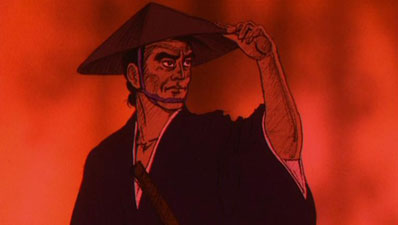
Muramasa (1987, 8:42) – I think you have to be Japanese to really “get” this samurai story. Interesting to look at, but to me it is the most distant piece on the DVD despite having a lyrical flow. The painterly backgrounds are nice, though.
Legend Of The Forest (1987, 29:25) – Yes, there is an environmental message here, but that’s not what makes this featurette unique. By now, everyone has been able to appreciate Tezuka’s main themes, after all. No, this little film is unique for the structure it employs. Watching it takes one through a history of animation techniques, as it weaves its tale of squirrel versus man, evolving into nature versus mankind. It begins with single images, in the style of detailed woodcuts, but as the story progresses, each new emotional chord is displayed by a succession of styles that mirrors animation history. From the single images and simple story, we get simple chalk-like animation, a riff on Winsor McCay’s Gertie The Dinosaur, primitive rubber hose styling, increasingly detailed backgrounds, the use of a revolving live background object a la Max Fleischer, a decidedly Flowers And Tress color approach, and onwards towards Miyazaki-styled detail in both figures and storyline. Early on, when timeline appropriate, there are even squirrels running around inside a zoetrope! There were probably other references that I missed, too, but that’s okay since the whole conception and realization of this featurette is marvellous, and the story is also pretty involving.
Self Portrait (1988, 0:13) – So brief, I shouldn’t even say anything about it!
To call any of these films a mini-masterpiece is to diminish the others. Truthfully, they are all wonderful in their own way.

Is This Thing Loaded?
The sole extra on this disc is pretty good. The Interview With Tezuka (18:19) is all talking head (complete with his trademark beret, of course), but that’s okay when one can get such honest remarks from a creator. Much of the conversation is regarding 1984’s Jumping, but he does get into how all of his experimental films were financed by himself, for the purpose of furthering the art of animation and conveying personal messages. He did not feel his work could be properly evaluated in Japan, but enjoyed appealing to the international market. Particularly interesting are his comments regarding computer animation, describing it as “banal,” though he did rightfully predict that it would evolve substantially from where it was in the mid-1980s. He also expresses his disdain for his television work, which he views as purely commercial and generally without merit.

Case Study:
The packaging for this release borders on utilitarian. It’s just a standard keep case, with no insert. That’s fine, but the case looks a little too understated. I guess Kino was going for classy, but what they got really undersells the contents. The front of the case is mostly black, with the front and back having a number of screen captures from the films, filmstrip style; but each is shown with the same boring cloudy grey background. Instead of showcasing the diversity of the contents, Kino has chosen to make them appear unappealingly uniform… and boring. Way to go, guys. Also, the tiny grey letters on the back of the case don’t read particularly well on the black background either. At least the contents listing on the back does a mostly nice job of summarizing the disc’s cartoon shorts, complete with runtimes, though the aspect ratios given aren’t always accurate (16:9 is not the same as 2.35:1).
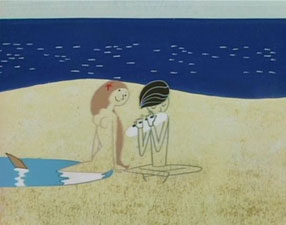
Ink And Paint:
While not as impressive as a more modern film would be, I was nevertheless impressed by the video quality of this release. Considering how obscure these films are to the general public, and not knowing what to expect of Mushi’s or Tezuka Productions’ archiving methods, I was expecting a worse result. These DVD transfers are really quite good. There is an odd bit of dust present, as with any traditionally made animated film, but overall these transfers are quite clean, and there are only minor instances of compression artifacts like shimmer that you really have to look for to see.
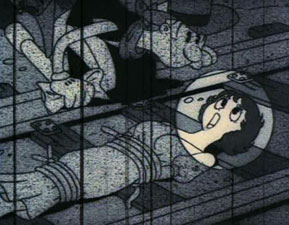
As I mentioned, there are a number of different aspect ratios. Of the thirteen films, ten are in the 4:3 ratio. Muramasa is 16:9. Tales Of The Street Corner and Pictures At An Exhibition are closer to 2.35:1. Incidentally, Legend Of The Forest is 4:3, though the package calls it 16:9. This may even be a mastering error, as round objects look wrongly ovular; perhaps segments in this were supposed to expand to 16:9?
Scratch Tracks:
The stereo sound on the disc naturally improves as the films get older, but there is nothing inherently wrong with any of the audio tracks. By the time you get to Legend Of The forest, though, the music becomes even richer and more percussive. For the few shorts that have any dialog, English subtitles are provided.
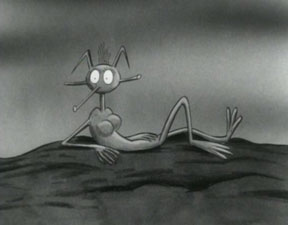
Final Cut:
You may have had your interest piqued by your knowledge of Astro Boy, but if so you are in for a wonderful surprise. This collection of shorts and featurettes plays as its own animated film festival, using a variety of styles while adhering to some common themes. It works beautifully on disc, too, because none of these films seem dated. I would have been hard pressed to try to put these films in chronological order if they weren’t presented so on the DVD. Each one is a little marvel, exquisitely produced by a master artist. Only the samurai picture threatened to lose me, due mainly to cultural factors, but even it was a pleasure to view. Once I got going on this DVD, I couldn’t take a break. Even my kids were along for the whole ride (though I fortunately had screened a few before they watched them, so I managed to avoid showing them the disturbing Male.) Even if the themes of the films may be too big for young minds, most of these films make for wonderful family viewing. With these as an introduction, I know I shall be seeking out more works associated with Tezuka.
 | ||
 |







